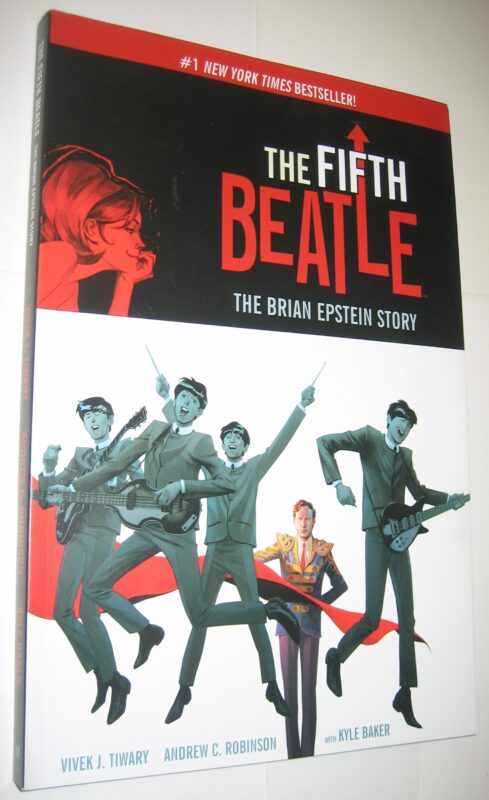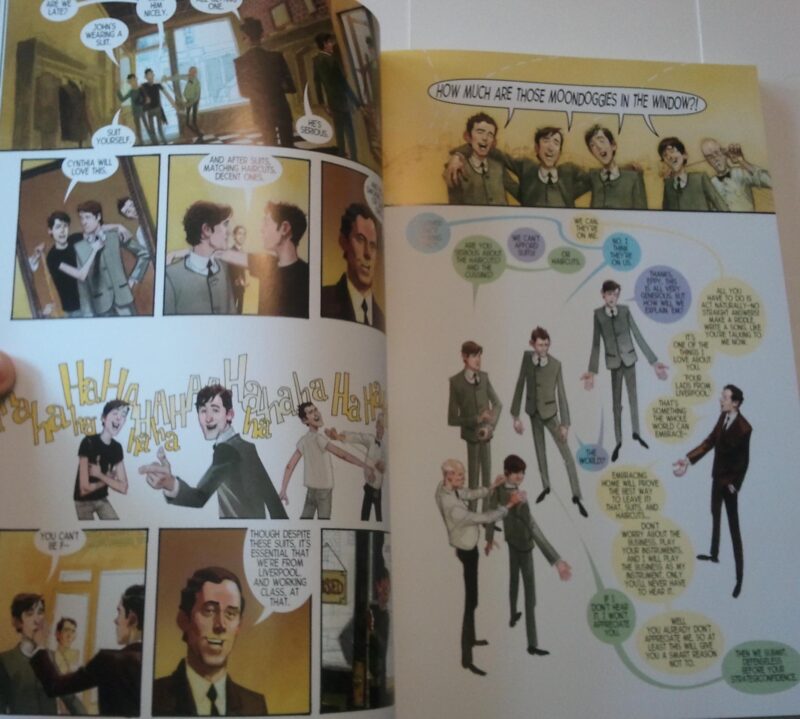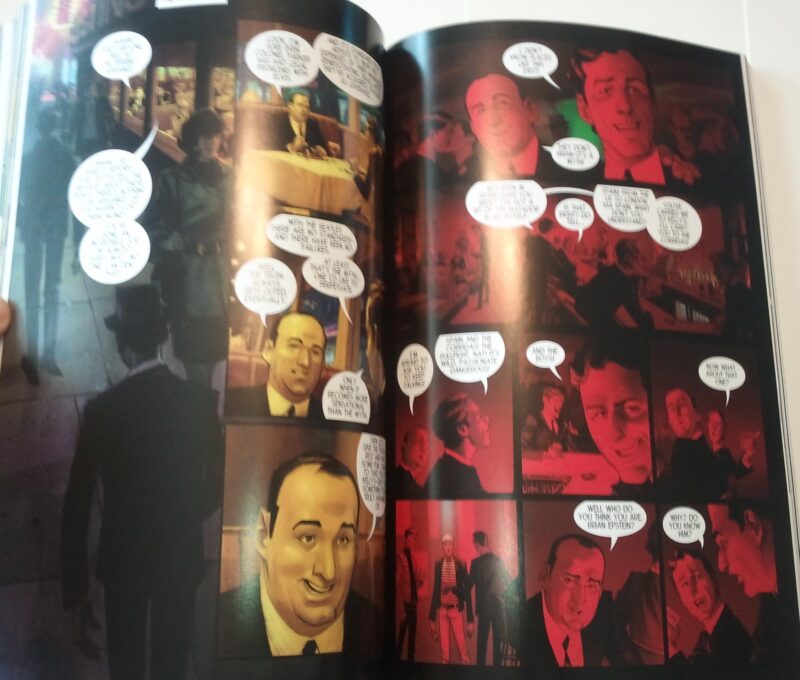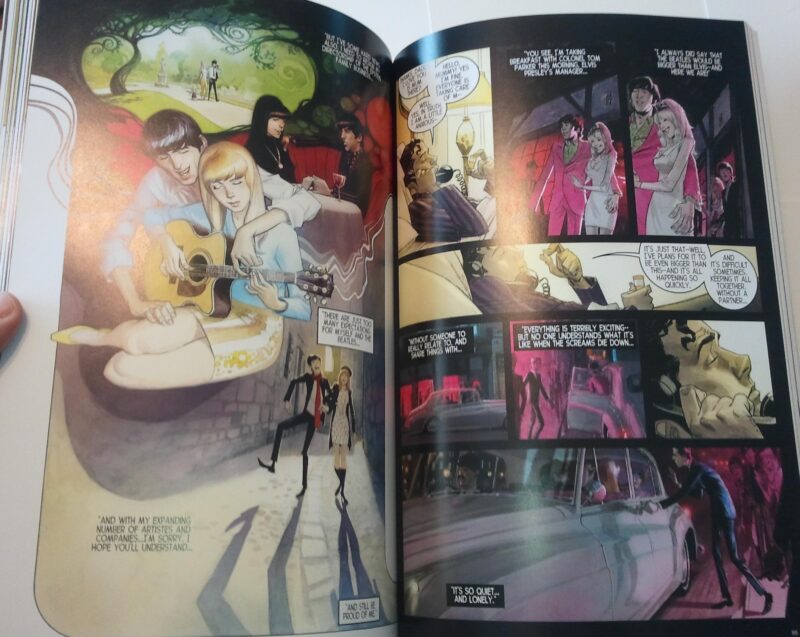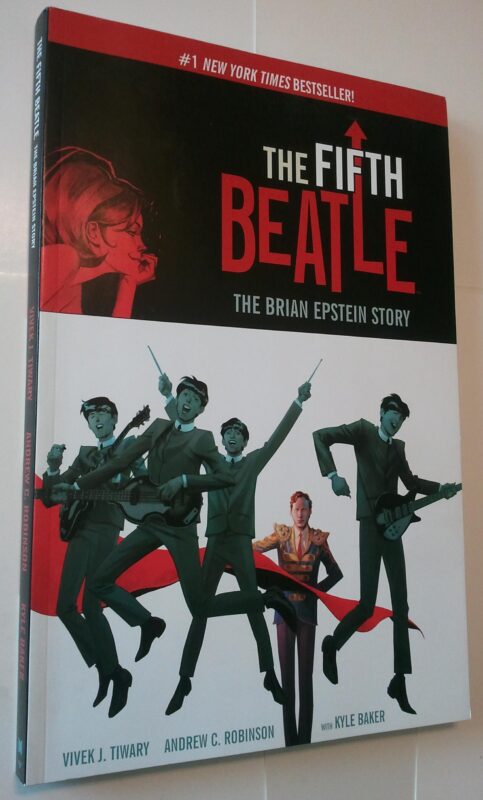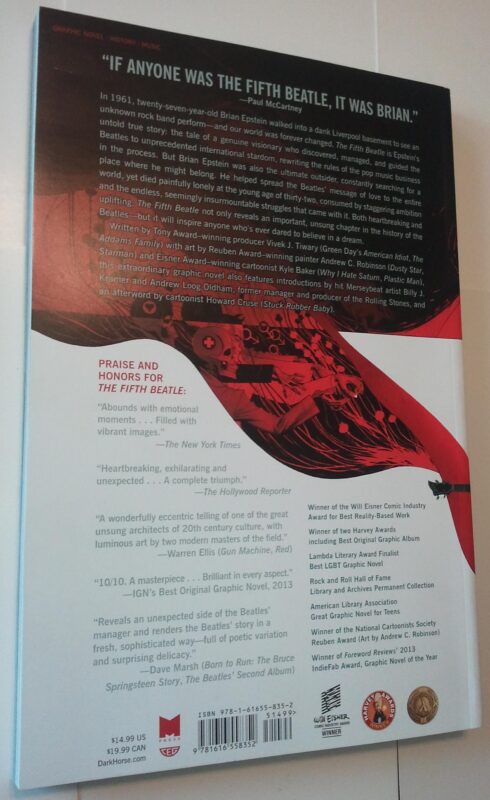Fifth Beatle The Brian Epstein Story TP NM Vivek Tiwary Andrew Robinson Get Back 1st print
$69.99
Description
FIFTH BEATLE: THE BRIAN EPSTEIN STORY SC (DARK HORSE COMICS)
by Vivek J. Tiwary (Author), Andrew C. Robinson (Illustrator), Kyle Baker (Illustrator)
Eisner and Harvey Award winner!
#1 New York Times bestseller.
”If anyone was ‘The Fifth Beatle’ it was Brian.” Paul McCartney
The Fifth Beatle graphic novel recounts the untold true story of Brian Epstein– the visionary manager who created Beatlemania and guided the Beatles from basement gigs to unprecedented international stardom. It’s also an uplifting, inspirational human story about the struggle to overcome seemingly insurmountable odds. This critically acclaimed and multiple award winning graphic novel has been added to the Rock and Roll Hall of Fame Library and Archives and a film adaptation begins shooting in 2015!
This new softcover edition includes an expanded sketchbook and Beatles memorabilia section, with behind-the-scenes essays and insights from writer Vivek J. Tiwary, plus 25 pages of bonus art by Andrew Robinson and Kyle Baker!
“ Heartbreaking, exhilarating and unexpected . . . A complete triumph.” The Hollywood Reporter
The Fifth Beatle is now being adapted into a feature film that has secured unprecedented access to Beatles music and is on-track to shoot in 2015. Last year, it was announced that Im Global and Simon Cowell’s Cyco Entertainment were teaming up for an adaptation of Vivek J. Tiwary’s The Fifth Beatle: The Story of Brian Epstein, but it seems that project has fallen apart as Deadline is reporting that Sonar Entertainment has now optioned the rights to the graphic novel and is planning a multi-part TV event series.
Publisher ? : ? Dark Horse
Language ? : ? English
Paperback ? : ? 176 pages
This book is a fascinating look at the contributions of Brian Epstein to the success of the Beatles. I am very aware of the role Brian played and very much enjoyed this approach to telling the story. The art work is beautiful, and Brian’s story is told in a sensitive caring manner. This book is a must-have for all real Beatles fans.
When Hunter Davies’ biography of the Beatles was nearing publication in 1968, its author had almost forgotten to clear the manuscript with the mother of Brian Epstein, the man who shepherded the Liverpool, England “guitar group” to interstellar wealth and popularity. Beatles manager Epstein put together the original contract that solidified Davies as band’s authorized biographer, and as Brian had died of an accidental drug overdose by then, Davies was obligated to show his draft to Mrs. Queenie Epstein. She objected to any mention of her son’s homosexuality in the book. Outside of a stray appearance of the then-ambiguous phrase “gay bachelor,” the biographer had to edit as directed.
“With Brian,” wrote Davies in his introduction to the expanded 1985 edition of The Beatles, “I think (Epstein’s sex life) did matter, and it was a vital clue to his personality, to his death, and also to the birth of his interest in the Beatles.” The United Kingdom was a bigoted, repressive, and dangerous environment for a homosexual back then; Epstein closely guarded his orientation. Even as The Fifth Beatle graphic novel is far from exhaustive, theatre producer Vivek J. Tiwary handles Brian’s secret with great care, tracing his under-reported ascension from managing the music department of his old man’s furniture store to the role that would dramatically alter every corner of his life.
Brian Epstein glides about in artist Andrew C. Robinson’s era-appropriate composite of cinematic framing and psychedelic overtones, clad in conservative blue or brown pinstripe suits. Each panel’s impossible Valley of the Dolls-like gloss — occasionally dressed in an effect that reproduces a color camera filter — owes to Robinson’s paint-first, digital studio-second methodology. He sets Northern England in a striking rain-blanketed swirl of blues, mossy green, and unfriendly damp alleyways, and The Fifth Beatle’s first few pages unfurl near the River Mersey, where an early Beatles gig is cross-cut with a harrowing encounter along the Liverpool South Docks. Epstein approaches a young seaman under the misconception he’d been flirted with and is “beaten…badly,” as recounted in the novel. Robinson’s whirlwind of punches and sharp kicks comes to a head with Epstein limping away, bleeding all over a discarded issue of Mersey Beat. It mirrors closely his perilous late-night stop-offs in the early 1960s, and Epstein’s romantic entanglements in Tiwary’s script prove just as tragic. “(Brian) cruised in some terrible places,” Beatles affiliate Terry Doran told The Washington Post’s Glenn Frankel in 2007. “[…] He was a glutton for punishment, really.” Epstein exhausted himself, too — Robinson’s widescreen depictions of tumbling pills in The Fifth Beatle follow exchanges with doctors who scribble prescriptions for fatigue as well as for his “intimate inclinations.”
Not far from the menacing docks meet-ups, Epstein first experiences the Beatles at the Cavern Club (“…black as a deep grave, dank and damp and smelly,” reported Brian and ghostwriter Derek Taylor in Epstein’s autobiography A Cellarful of Noise). Robinson fits the then-unpolished, slender four-piece with slick black leather jackets and tousled long hair. The Beatles were a scrappy local band in 1961, and between drinking, smoking, and eating lunch onstage, they stormed through Little Richard and Buddy Holly covers for meager pay. Bored with his father’s store, Brian quickly secured a business relationship with the lads, shaping everything from merchandise and tour contracts (which he often bungled) to manners and haircuts. Helming the act’s business, promotion, and media affairs was a daunting, time-swallowing task for The Fifth Beatle’s fastidiously attired Englishman, but Tiwary’s subject is driven and ambitious. “I think with my help these boys could be stars,” he says after the rowdy early show. The renderings of the initial Epstein-Beatles interactions are vibrant and funny, with Robinson locking down the small things like the familiar angular crest of John Lennon’s nose. While the plotting here recreates exactly the volley of banter we love in A Hard Day’s Night, it seems that getting the larger picture into The Fifth Beatle was a bit more difficult.
What is all the fuss about the graphic novel by Vivek J. Tiwary, Andrew C. Robinson and Kyle Baker about Brian Epstein, The Beatles’ manager? This book has been getting a great deal of attention due to the fact that it not only will be made into a feature film by Simon Cowell’s Syco Entertainment, but also a multi-part television series with Sonar Entertainment.
The Fifth Beatle: The Brian Epstein Story is a visually elaborate re-telling of Beatles’ history as seen through the perspective of their manager, who many including Paul McCartney have called “The Fifth Beatle.” However, that title is not an exclusive one. Recently, after Beatles’ producer George Martin died, Paul McCartney also deemed him “The Fifth Beatle.”
However, Epstein may deserve the title more since without him, The Beatles may have never made it out of Liverpool. It was Brian who persevered in acquiring The Beatles a record contract in England after repeated rejection. It was Brian who negotiated their debut in America with Capitol Records and Ed Sullivan. It was Brian who encouraged them to clean up their act to be presentable to the public. Brian may have believed in The Beatles more than they themselves did.
To tell the complete history of The Beatles, a graphic novel can be a challenging format. Due to the comic book layout, The Fifth Beatle tells its story through more of a screenplay or storyboard format rather than a traditional book, which explains why it can easily be envisioned for the screen. Unlike other graphic novels, The Fifth Beatle leaves out a narrator. As a result, the characters are required to explain much more through their words than they probably did in actuality.
A key drawback of a biographical film adapted from a book is that it leaves out many important facts and details. In some instances, the film creates new truths to satisfy dramatic effect in order to make the movie more entertaining – what is commonly known as “dramatic license.”
Unfortunately, right off the bat, author Tiwary admits that the truth wasn’t a priority to him in his book in telling Brian Epstein’s story: “Almost everything in the pages you’ve just read actually did happen” Tiwary writes. “But conveying the truth – while important – has never been my primary goal.”
Tiwary’s goal was “to reveal not just the facts but the poetry behind the Brian Epstein story.” He certainly finds inspiration and admiration for Epstein in all the obstacles he faced, not only in promoting The Beatles, but dealing with his closeted homosexuality. But that doesn’t excuse perpetuating detrimental myths back into Beatles’ lore. These “truths” used for drama are harmful to the legacy of The Beatles.
For example, The Fifth Beatle depicts Brian Epstein as purposely buying 10,000 copies of The Beatles first single “Love Me Do” in order to get it higher on the UK charts. Great for dramatic effect, but not so great if you’re into the truth.
Beatles historian and author, Mark Lewisohn, definitively states in his recent book, Tune In: The Beatles: All These Years, Volume 1, that Epstein did not do this and that this nasty rumor “unfairly casts a blight on his integrity.”
As John Lennon stated: “It [Love Me Do] sold so many in Liverpool the first two days — because they were all waiting for us to make it — that the dealers down in London thought there was a fiddle on. ‘That Mr. Epstein feller up there is cheating.’ But he wasn’t.”
Tiwary further implies that Epstein also overbought quantities of “Please Please Me” for his NEMS record shops to help it reach number one. Mark Lewisohn’s research refutes that explaining that “in 1962, it made no difference how many copies a shop sold of any record because the charts weren’t computed that way.”
Note: A special Collector’s Edition of The Fifth Beatle was recently released which includes a unique textured cover and a section of bonus materials with rare Beatles and Brian Epstein memorabilia, artist sketches and alternate covers.
At 130 pages (introspective back matter aside), Epstein’s launch of his Liverpool act gets a rush job in Vivek Tiwary’s final draft. Firing then-drummer Pete Best and replacing him with Ringo Starr was left to the uncomfortable new manager, for example, and it doesn’t make it into the book. The move yielded physical attacks from Best’s rabid fan base, and George Harrison earned a black eye. Later, The Fifth Beatle’s presentation of the band’s 1966 Philippines trip is handled curiously, too. It culminated in a return to the States only to find Beatles records being publicly burned due to John Lennon’s “bigger than Jesus” remark. But the episode moves at a breakneck pace here, and collaborating artist Kyle Baker resurrects the era’s Saturday morning cartoon Fabs to speedily tell the tale. The Manila visit actually turned frightening (and a bit violent) when Epstein unintentionally snubbed first lady Imelda Marcos by declining a breakfast invitation on behalf of his clients, so the choice to lighten it with Baker’s albeit lively pen work and florid pastels is a puzzling one. And while Tiwary’s work emphasizes the string of tender relationships that Epstein fostered during his adult life, the death of Brian’s father – just weeks before Epstein passed – didn’t make it through The Fifth Beatle’s editing stage either.
Harry Epstein died while anxiety and severe loneliness was wearing his son into the ground. Brian was cycling through anti-depressants and sedatives for insomnia while he tended to his grieving mother. “Drugs became his crutch,” writes Beatles historian Paul Du Noyer of the younger Epstein’s struggles in 1967. When Beatles touring was halted late in the year previous, a shift toward studio experimentation and away from humming day calendars effectively condensed their manager’s role and their communication with him. Unlikely as it seems, Epstein had become unraveled by loneliness. The dark days that followed would produce temper tantrums, suicide attempts, and deep-seated feelings of abandonment. There, at the flowering center of post-Beatlemania, the fifth Beatle was an outsider. This graphic telling doesn’t much delve into the period, opting for a weightless, intangible treatment that involves ambling conversations and strange visits with a bed-stricken Brian. It’s a whitewashing that’s ultimately preferable to the truth: A police report detailing the recovery of 17 pill bottles in Brian’s home and a probe that attributed his accidental death to a toxic brew of anti-depressants, barbiturates, and sleeping pills. When his housekeeper found him dead in August of 1967, Brian Epstein was 32.
“I think Brian’s one of the forgotten people,” Lennon’s first wife Cynthia told the The Washington Post’s Frankel. “It’s almost as if he’s been written out of the story. I don’t think they’d have got anywhere without Brian”.
978-1-61655-835-2
Near mint condition, 1st printing.
Related products
-
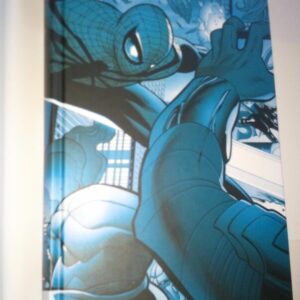
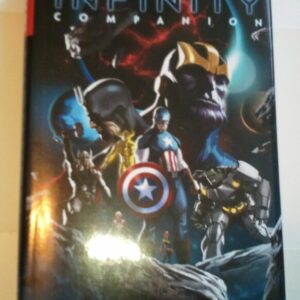
Infinity Companion Omnibus HC 1st print Guardians of the Galaxy X-Men Thanos
$199.99 Add to cart -
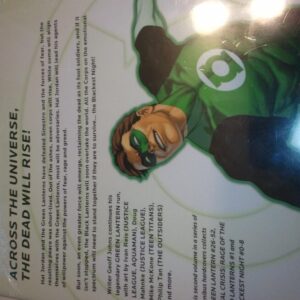
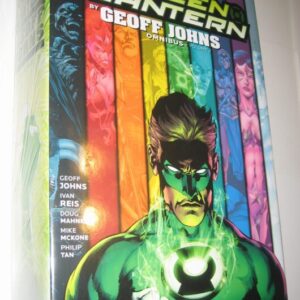
Green Lantern by Geoff Johns Volume 2 Omnibus HC 1st print NM Ivan Reis Shrinkwrapped
$324.99 Add to cart -
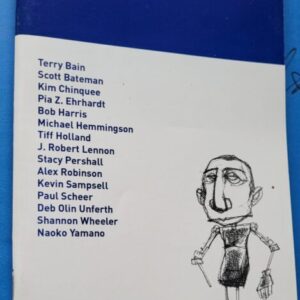
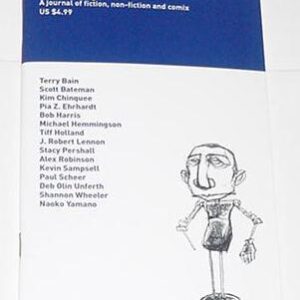
Unruly A Comix + Literary Journal 1 Alex Robinson
$39.99 Add to cart -
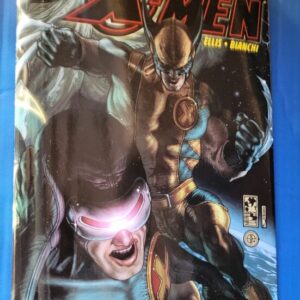
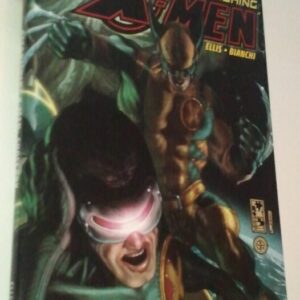
Astonishing X-Men: Ghost Box HC 1st print Warren Ellis Simone Bianchi Alan Davis
$99.99 Add to cart

